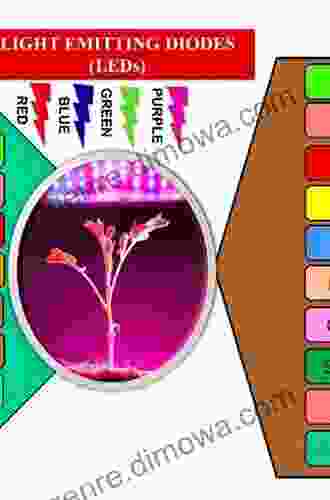Unlocking the Potential of LEDs for Advanced Agriculture: A Comprehensive Guide

Light Emitting Diodes (LEDs) have emerged as a game-changing technology in the field of agriculture, revolutionizing lighting solutions for crop production. These highly efficient and versatile light sources offer unparalleled control over light intensity, spectrum, and duration, enabling growers to tailor illumination specifically to the needs of their crops. By understanding the unique advantages of LEDs, farmers can unlock a world of possibilities to optimize plant growth, increase yield, and enhance overall crop quality. 4.2 out of 5 LEDs emit light through a process called electroluminescence, where an electrical current passing through a semiconductor material creates photons of light. Unlike traditional lighting sources, LEDs do not produce heat as a byproduct, making them highly energy-efficient. Additionally, LEDs have a long lifespan and can withstand harsh environmental conditions, ensuring reliable performance over extended periods. One of the most significant advantages of LEDs is their tunable spectrum. By adjusting the composition of the semiconductor material, manufacturers can precisely control the wavelength and intensity of the emitted light. This allows growers to create lighting environments that match the specific light requirements of different plant species and growth stages. LED lighting has a wide range of applications in agriculture, from improving crop production in greenhouses to supporting vertical farming operations. Here are some of the most notable applications: The adoption of LED lighting in agriculture brings numerous benefits, including: Designing an effective LED lighting system for agriculture requires careful consideration of several factors: Numerous case studies and success stories demonstrate the transformative impact of LED lighting in agriculture. Here are a few examples: Light Emitting Diodes (LEDs) represent a transformative technology for the agricultural industry. By providing precise control over light intensity, spectrum, and duration, LEDs empower growers to optimize crop production, increase yield, and enhance crop quality. As LED technology continues to advance, growers will have access to even more sophisticated and efficient lighting solutions, further revolutionizing the agricultural sector and meeting the growing demand for sustainable food production. To learn more about the latest advancements in LED lighting for agriculture, consider purchasing the comprehensive guide, "Light Emitting Diodes For Agriculture Smart Lighting." This valuable resource provides in-depth information on LED lighting design, applications, and benefits, empowering growers to harness the full potential of this transformative technology. to LED Lighting in Agriculture
Language : English File size : 7633 KB Text-to-Speech : Enabled Enhanced typesetting : Enabled Print length : 566 pages Screen Reader : Supported X-Ray for textbooks : Enabled Understanding the Science of LED Lighting
Applications of LED Lighting in Agriculture
Benefits of LED Lighting for Agriculture
LED Lighting Design for Agriculture
Case Studies and Success Stories
4.2 out of 5
| Language | : | English |
| File size | : | 7633 KB |
| Text-to-Speech | : | Enabled |
| Enhanced typesetting | : | Enabled |
| Print length | : | 566 pages |
| Screen Reader | : | Supported |
| X-Ray for textbooks | : | Enabled |
Do you want to contribute by writing guest posts on this blog?
Please contact us and send us a resume of previous articles that you have written.
 Book
Book Novel
Novel Page
Page Chapter
Chapter Text
Text Story
Story Genre
Genre Reader
Reader Library
Library Paperback
Paperback E-book
E-book Magazine
Magazine Newspaper
Newspaper Paragraph
Paragraph Sentence
Sentence Bookmark
Bookmark Shelf
Shelf Glossary
Glossary Bibliography
Bibliography Foreword
Foreword Preface
Preface Synopsis
Synopsis Annotation
Annotation Footnote
Footnote Manuscript
Manuscript Scroll
Scroll Codex
Codex Tome
Tome Bestseller
Bestseller Classics
Classics Library card
Library card Narrative
Narrative Biography
Biography Autobiography
Autobiography Memoir
Memoir Reference
Reference Encyclopedia
Encyclopedia Kurth Krause
Kurth Krause Lacey Lane
Lacey Lane Lara Hays
Lara Hays Simon Winder
Simon Winder Mz Lady P
Mz Lady P Larry Kinder
Larry Kinder Steve Ulfelder
Steve Ulfelder Mathew J Bartkowiak
Mathew J Bartkowiak Scott Tappa
Scott Tappa T F Rhoden
T F Rhoden Walter Fano
Walter Fano Kylie Key
Kylie Key Richard Aldrich
Richard Aldrich Kyler Doss
Kyler Doss Little Mix
Little Mix Dale Peterson
Dale Peterson Robert B Camp
Robert B Camp Kish Knight
Kish Knight Tom Judd
Tom Judd S D Hollick
S D Hollick
Light bulbAdvertise smarter! Our strategic ad space ensures maximum exposure. Reserve your spot today!

 Ray BlairClarifying Concepts In Physics New Ideas Answers: Unraveling the Mysteries of...
Ray BlairClarifying Concepts In Physics New Ideas Answers: Unraveling the Mysteries of...
 Francis TurnerImmerse Yourself in the Underwater World: English Words for Scuba Diving...
Francis TurnerImmerse Yourself in the Underwater World: English Words for Scuba Diving... Robert ReedFollow ·18.8k
Robert ReedFollow ·18.8k Branden SimmonsFollow ·5.4k
Branden SimmonsFollow ·5.4k Christian BarnesFollow ·6.7k
Christian BarnesFollow ·6.7k Dalton FosterFollow ·14.7k
Dalton FosterFollow ·14.7k Quentin PowellFollow ·15.6k
Quentin PowellFollow ·15.6k Zachary CoxFollow ·7.4k
Zachary CoxFollow ·7.4k Dion ReedFollow ·19.5k
Dion ReedFollow ·19.5k W.H. AudenFollow ·6.5k
W.H. AudenFollow ·6.5k

 Langston Hughes
Langston HughesUnlock Your Teaching Dreams with Nystce Mathematics 004...
Elevate Your Preparation...

 Finn Cox
Finn CoxUnlock Your Mtel Music 16 Certification: A Comprehensive...
: Embark on the Path...

 Calvin Fisher
Calvin FisherThe Unforgettable Journey of Self-Discovery in "Out of...
An Extraordinary Journey of Growth and...

 Isaiah Price
Isaiah PriceWhy Am I So Happy Dating With a Bolivian Girl?
I've been dating my...

 Junichiro Tanizaki
Junichiro TanizakiVolume: The Hole Inside the Earth - Discover the...
Delve into the...
4.2 out of 5
| Language | : | English |
| File size | : | 7633 KB |
| Text-to-Speech | : | Enabled |
| Enhanced typesetting | : | Enabled |
| Print length | : | 566 pages |
| Screen Reader | : | Supported |
| X-Ray for textbooks | : | Enabled |










